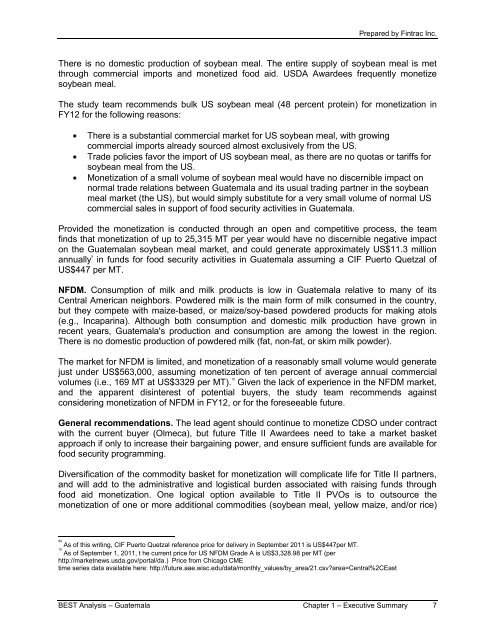usaid office of food for peace guatemala bellmon estimation
usaid office of food for peace guatemala bellmon estimation
usaid office of food for peace guatemala bellmon estimation
Create successful ePaper yourself
Turn your PDF publications into a flip-book with our unique Google optimized e-Paper software.
Prepared by Fintrac Inc.<br />
There is no domestic production <strong>of</strong> soybean meal. The entire supply <strong>of</strong> soybean meal is met<br />
through commercial imports and monetized <strong>food</strong> aid. USDA Awardees frequently monetize<br />
soybean meal.<br />
The study team recommends bulk US soybean meal (48 percent protein) <strong>for</strong> monetization in<br />
FY12 <strong>for</strong> the following reasons:<br />
There is a substantial commercial market <strong>for</strong> US soybean meal, with growing<br />
commercial imports already sourced almost exclusively from the US.<br />
Trade policies favor the import <strong>of</strong> US soybean meal, as there are no quotas or tariffs <strong>for</strong><br />
soybean meal from the US.<br />
Monetization <strong>of</strong> a small volume <strong>of</strong> soybean meal would have no discernible impact on<br />
normal trade relations between Guatemala and its usual trading partner in the soybean<br />
meal market (the US), but would simply substitute <strong>for</strong> a very small volume <strong>of</strong> normal US<br />
commercial sales in support <strong>of</strong> <strong>food</strong> security activities in Guatemala.<br />
Provided the monetization is conducted through an open and competitive process, the team<br />
finds that monetization <strong>of</strong> up to 25,315 MT per year would have no discernible negative impact<br />
on the Guatemalan soybean meal market, and could generate approximately US$11.3 million<br />
annually 9<br />
in funds <strong>for</strong> <strong>food</strong> security activities in Guatemala assuming a CIF Puerto Quetzal <strong>of</strong><br />
US$447 per MT.<br />
NFDM. Consumption <strong>of</strong> milk and milk products is low in Guatemala relative to many <strong>of</strong> its<br />
Central American neighbors. Powdered milk is the main <strong>for</strong>m <strong>of</strong> milk consumed in the country,<br />
but they compete with maize-based, or maize/soy-based powdered products <strong>for</strong> making atols<br />
(e.g., Incaparina). Although both consumption and domestic milk production have grown in<br />
recent years, Guatemala's production and consumption are among the lowest in the region.<br />
There is no domestic production <strong>of</strong> powdered milk (fat, non-fat, or skim milk powder).<br />
The market <strong>for</strong> NFDM is limited, and monetization <strong>of</strong> a reasonably small volume would generate<br />
just under US$563,000, assuming monetization <strong>of</strong> ten percent <strong>of</strong> average annual commercial<br />
volumes (i.e., 169 MT at US$3329 per MT). 10<br />
Given the lack <strong>of</strong> experience in the NFDM market,<br />
and the apparent disinterest <strong>of</strong> potential buyers, the study team recommends against<br />
considering monetization <strong>of</strong> NFDM in FY12, or <strong>for</strong> the <strong>for</strong>eseeable future.<br />
General recommendations. The lead agent should continue to monetize CDSO under contract<br />
with the current buyer (Olmeca), but future Title II Awardees need to take a market basket<br />
approach if only to increase their bargaining power, and ensure sufficient funds are available <strong>for</strong><br />
<strong>food</strong> security programming.<br />
Diversification <strong>of</strong> the commodity basket <strong>for</strong> monetization will complicate life <strong>for</strong> Title II partners,<br />
and will add to the administrative and logistical burden associated with raising funds through<br />
<strong>food</strong> aid monetization. One logical option available to Title II PVOs is to outsource the<br />
monetization <strong>of</strong> one or more additional commodities (soybean meal, yellow maize, and/or rice)<br />
99<br />
As <strong>of</strong> this writing, CIF Puerto Quetzal reference price <strong>for</strong> delivery in September 2011 is US$447per MT.<br />
10<br />
As <strong>of</strong> September 1, 2011, t he current price <strong>for</strong> US NFDM Grade A is US$3,328.98 per MT (per<br />
http://marketnews.usda.gov/portal/da.) Price from Chicago CME<br />
time series data available here: http://future.aae.wisc.edu/data/monthly_values/by_area/21.csv?area=Central%2CEast<br />
BEST Analysis – Guatemala Chapter 1 – Executive Summary 7

















